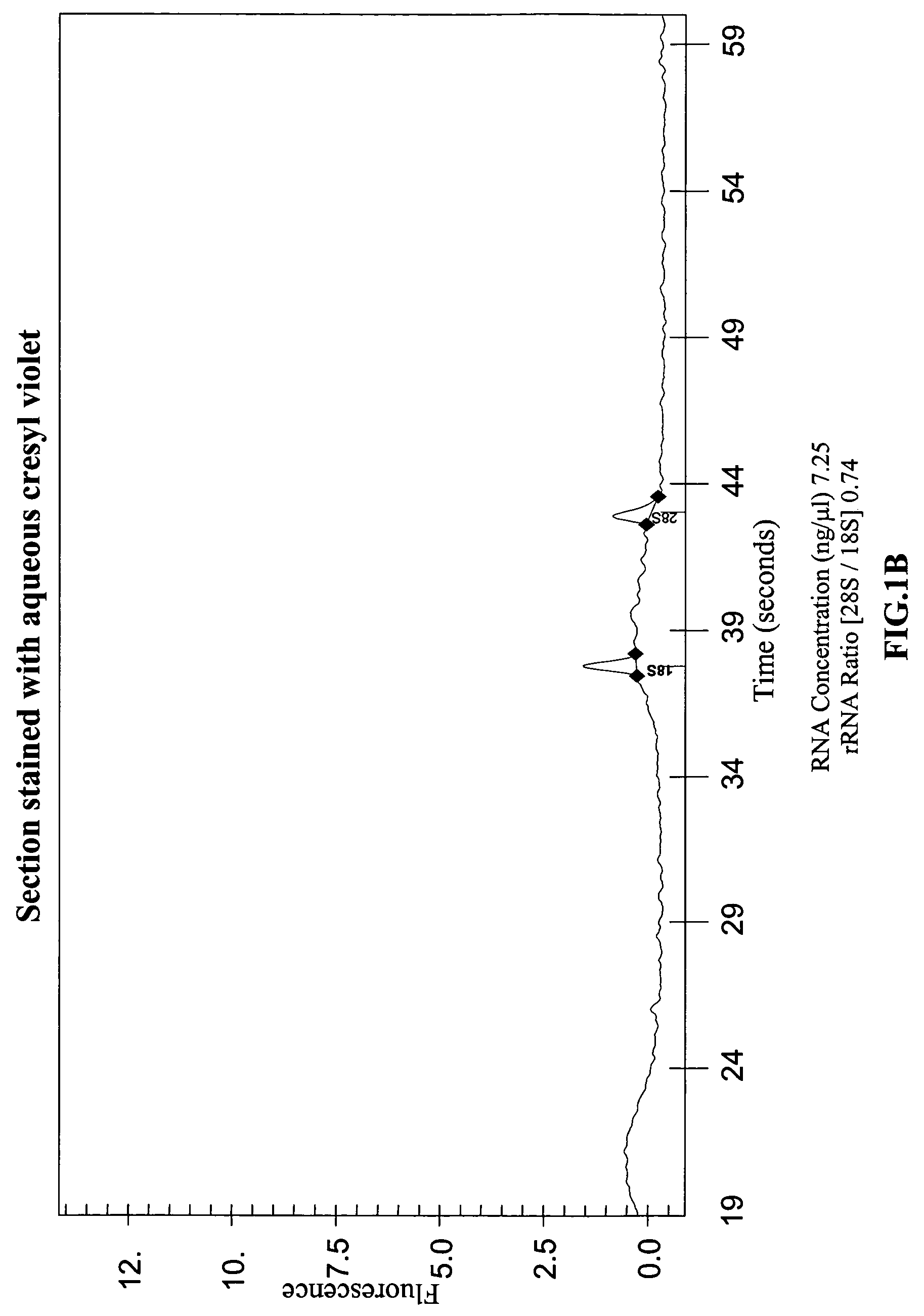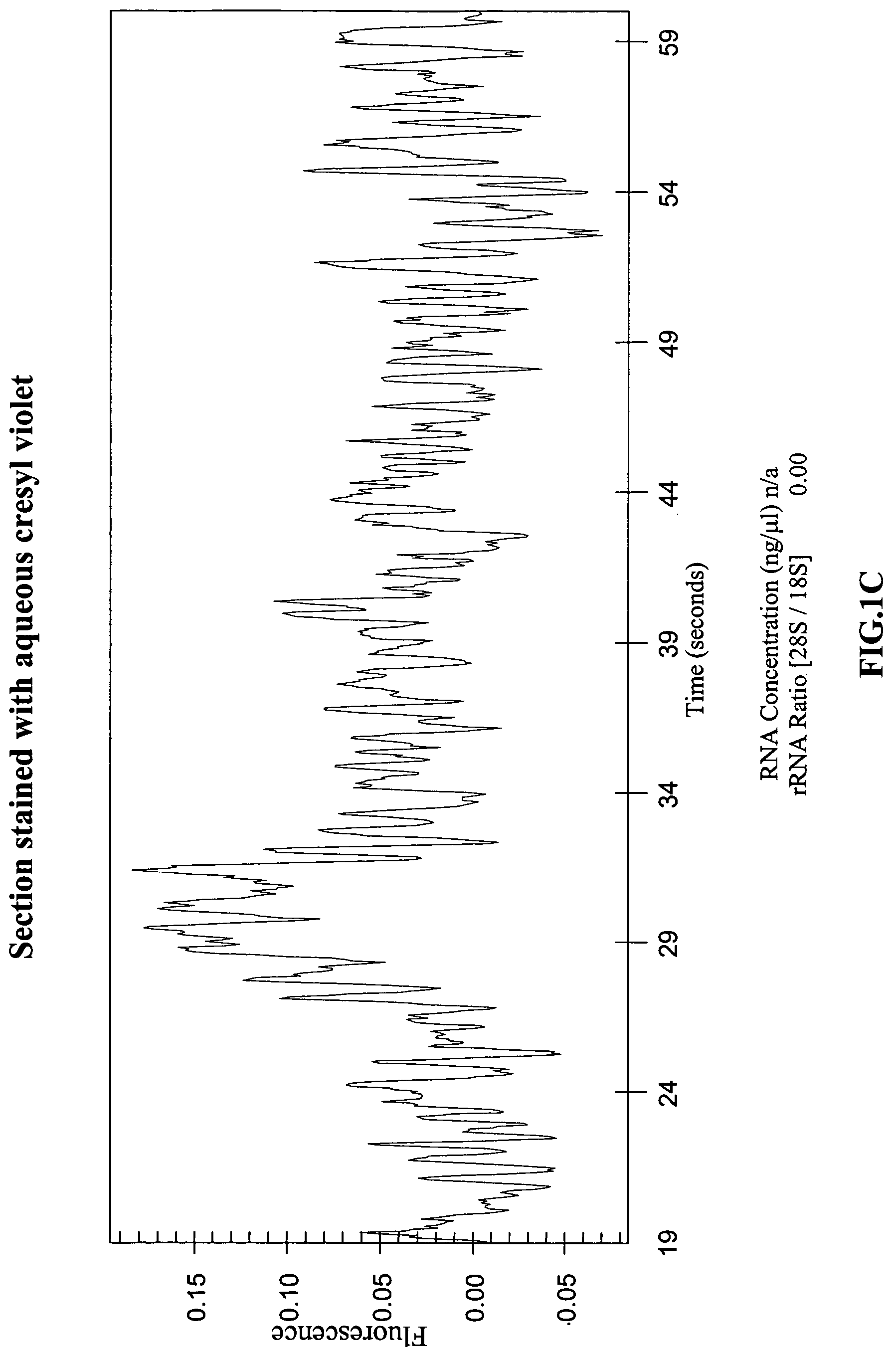Methods and compositions for preparing tissue samples for RNA extraction
a tissue sample and rna extraction technology, applied in the field of histology and molecular biology, can solve the problems of compromising the ability to extract intact rna and/or reverse transcription using rna from fixed samples, and achieving the effect of reducing carryover or contamination
- Summary
- Abstract
- Description
- Claims
- Application Information
AI Technical Summary
Benefits of technology
Problems solved by technology
Method used
Image
Examples
example 1
RNA Isolated from Tissue Sections Processed Using Published Procedures is Degraded
[0066]The effect of the various steps used to prepare tissue samples for LCM, and of the LCM process itself, on the yields and quality of RNA recovered was systematically investigated. Protocols described in the literature were used to process various mouse tissues and human tissues were obtained from the Co-operative Human Tissue Network (CHTN) and used to study the effects. The steps used to prepare frozen tissues for LCM and subsequent RNA recovery can be divided into four stages: 1) embedding and sectioning; 2) pre-staining fixation and hydration; 3) staining; and 4) post-staining processing and dehydration. The protocol recommended by Arcturus, Inc. for carrying out these steps is described in a technical bulletin, “Optimized Protocol for Preparing and Staining LCM Samples from Frozen Tissue and Extraction of High-Quality RNA” (found on the world wide web at arctur.com / images / pdf / HistoGene_Applica...
example 2
RNA Degradation is Not Due to RNase in Solutions and Surfaces
[0068]Since RNA degradation was observed in stained tissue, it was investigated whether this was due to RNase contamination of the reagents used. Histological stains such as hematoxylin / eosin, cresyl violet, and toluidine blue are typically made by dissolving powdered stains in water or in phosphate buffer. To rule out RNase contamination of the reagents used to make the stains, synthetic radiolabeled RNA transcripts were incubated for six hours with distilled water and with aqueous solutions of several histological stains, and then analyzed the transcripts on denaturing polyacrylamide gels. The stains tested included commercially available premixed solutions of eosin Y, Harris hematoxylin, and bluing reagent (ThermoShanndon RapidChrome Frozen Section Staining kit) and powdered stains including toluidine blue, cresyl violet, and hematoxylin (EM Science, Sigma and Aldrich). These experiments showed that the RNA degradation ...
example 3
Optimization of Pre-Staining Steps
[0070]Whether the 50% and 75% ethanol pre-staining steps could be eliminated was tested. Omitting these ethanol steps and incubating the sections in 95% ethanol directly before staining resulted in extremely poor tissue morphology, in fact it was impossible to bring the stained sample into sharp focus. The water component of the 50% and 75% ethanol solutions is probably required to dissolve the OCT embedding matrix which otherwise interferes with visualizing the tissue.
PUM
 Login to View More
Login to View More Abstract
Description
Claims
Application Information
 Login to View More
Login to View More - R&D
- Intellectual Property
- Life Sciences
- Materials
- Tech Scout
- Unparalleled Data Quality
- Higher Quality Content
- 60% Fewer Hallucinations
Browse by: Latest US Patents, China's latest patents, Technical Efficacy Thesaurus, Application Domain, Technology Topic, Popular Technical Reports.
© 2025 PatSnap. All rights reserved.Legal|Privacy policy|Modern Slavery Act Transparency Statement|Sitemap|About US| Contact US: help@patsnap.com



